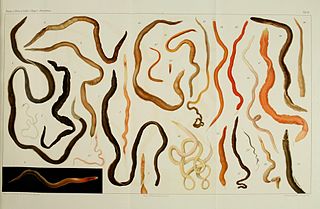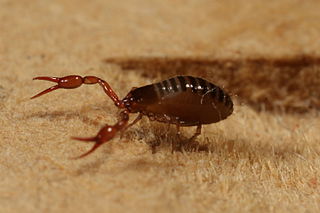 W
WCentruroides gracilis is a species of scorpion in the family Buthidae, the bark scorpions. Its common names include Florida bark scorpion, brown bark scorpion, and slender brown scorpion. In Cuba it is known as alacran prieto and alacran azul. It is native to northern parts of the middle Americas, including Mexico, Guatemala, Belize, and Honduras. It is present in other parts as an introduced species, including Cuba, Panama, Colombia, Ecuador, Jamaica, and Florida in the United States. It is also introduced in parts of Africa, including Cameroon and Gabon, as well as the Canary Islands.
 W
WCerebratulus marginatus is a proboscis worm in the family Lineidae. This ribbon worm has an Arctic distribution, and in the North Atlantic Ocean ranges as far south as Cape Cod and the Mediterranean Sea while in the Pacific Ocean it extends southwards to California.
 W
WChaetopterus variopedatus is a species of parchment worm, a marine polychaete in the family Chaetopteridae. It is found worldwide. However, recent discoveries from molecular phylogeny analysis show that Chaetopterus variopedatus sensu Hartman (1959) is not a single species.
 W
WMitostoma chrysomelas is an harvestmen species widely distributed in Central Europe, British Isles, France and Southeast to Bulgaria.
 W
WNeobisium carcinoides is a species of pseudoscorpions in the Neobisiidae family. It is found throughout Europe with the exception of Greece, Belarus, and Russia. The type locality is 7 km south of Strasbourg, in the Bas-Rhin department, Alsace, France.
 W
WPyrosoma atlanticum is a pelagic species of marine colonial tunicate in the class Thaliacea found in temperate waters worldwide. The name of the genus comes from the Greek words pyros meaning 'fire' and soma meaning 'body', referring to the bright bioluminescence sometimes emitted. The specific epithet atlanticum refers to the Atlantic Ocean, from where the first specimen of the species was collected for scientific description; it was described in 1804 by François Péron, a French naturalist.
 W
WSalpa fusiformis, sometimes known as the common salp, is the most widespread species of salp. They have a cosmopolitan distribution, and can be found at depths of 0 to 800 m. They exhibit diel vertical migration, moving closer to the surface at night. They can occur in very dense swarms, as solitary zooids or as colonies. Solitary zooids usually measure 22 to 52 mm in length. They are barrel-shaped and elongated, with a rounded front and a flat rear. Aggregate zooids are 7 to 52 mm in length individually. They are usually barrel or spindle-shaped.
 W
WTubulanus annulatus, commonly known as the football jersey worm, is a species of ribbon worm in the phylum Nemertea. It ranges across the northern Atlantic Ocean, the North Sea and the Mediterranean Sea, being present from the lower shore down to about 40 m (130 ft), on sand, gravel and other habitats.
 W
WTubulanus polymorphus is a species of ribbon worm in the phylum Nemertea. It is found in the northern Atlantic Ocean and the northern Pacific Ocean. It occurs on the lower shore down to about 50 m (160 ft), on sand or gravel, under stones and among seaweed.